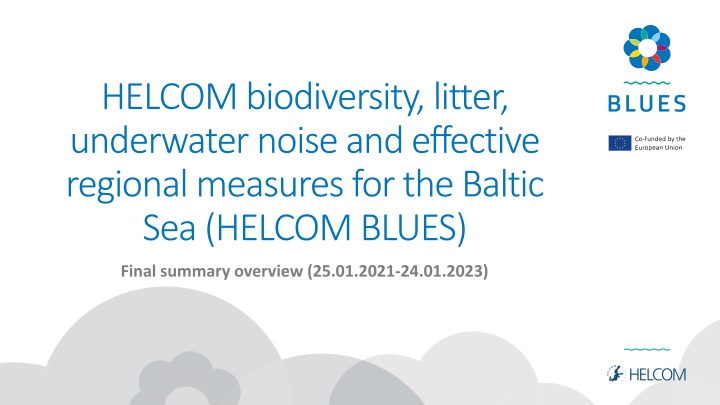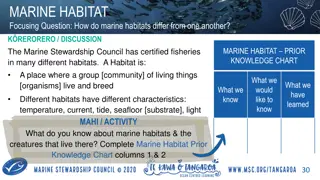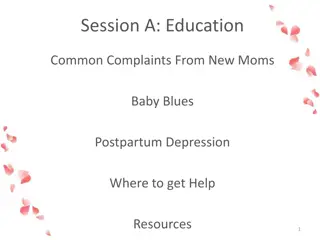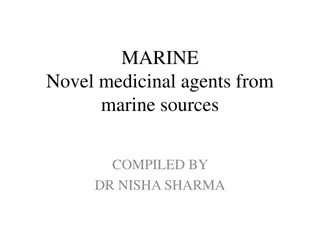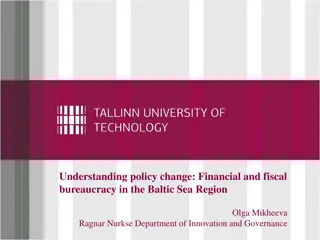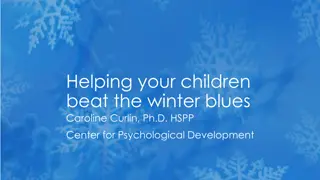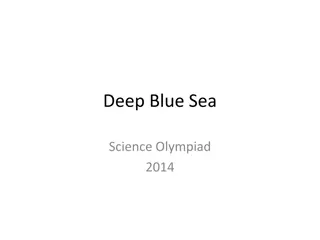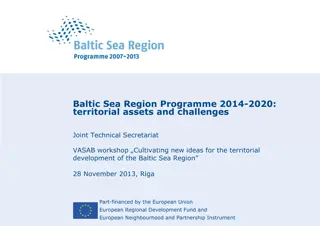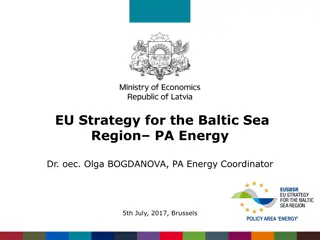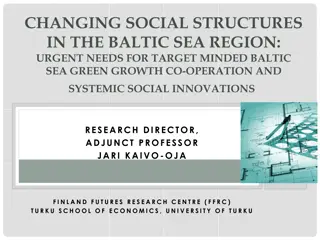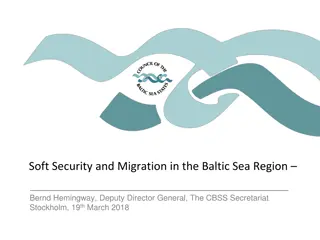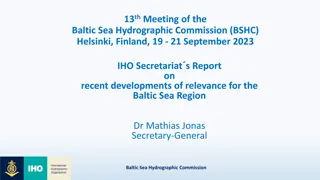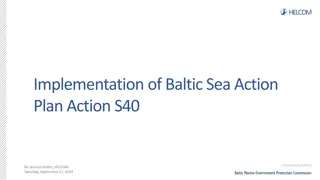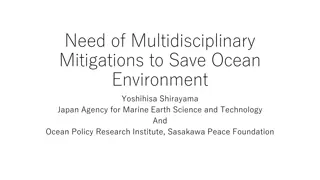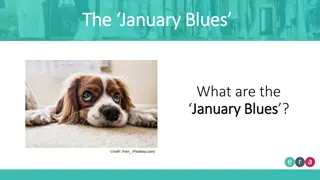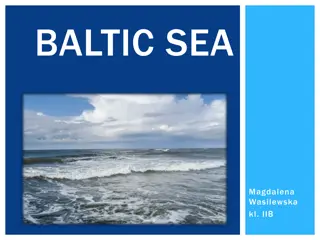Supporting Marine Environment in the Baltic Sea: HELCOM.BLUES Project Overview
The HELCOM.BLUES project focuses on biodiversity, litter, underwater noise, and regional measures for the Baltic Sea. It aims to enhance regional capacity for developing effective measures to maintain a healthy marine environment. The project involves a consortium of 14 partners and over 7 subcontractors from six Baltic Sea states. Key activities include improving frameworks for assessing measure effectiveness, collating data for cost analyses, and reviewing past work to enhance the assessment methodology and benefits estimation. The ultimate goal is to contribute to the sustainable management of the Baltic Sea ecosystem.
Download Presentation

Please find below an Image/Link to download the presentation.
The content on the website is provided AS IS for your information and personal use only. It may not be sold, licensed, or shared on other websites without obtaining consent from the author.If you encounter any issues during the download, it is possible that the publisher has removed the file from their server.
You are allowed to download the files provided on this website for personal or commercial use, subject to the condition that they are used lawfully. All files are the property of their respective owners.
The content on the website is provided AS IS for your information and personal use only. It may not be sold, licensed, or shared on other websites without obtaining consent from the author.
E N D
Presentation Transcript
HELCOM biodiversity, litter, underwater noise and effective regional measures for the Baltic Sea (HELCOM BLUES) Final summary overview (25.01.2021-24.01.2023)
Grant information Programme concerned: MARINE STRATEGY FRAMEWORK DIRECTIVE: SUPPORT TO THE PREPARATION OF THE NEXT 6-YEAR CYCLE OF IMPLEMENTATION Reference number of the call for proposals: DG ENV/MSFD 2020 call Grant agreement number: No. 110661/2020/839624/SUB/ENV.C.2 Title of the project: HELCOM biodiversity, litter, underwater noise and effective regional measures for the Baltic Sea (HELCOM BLUES) Objective: The aim of HELCOM BLUES is to support regional capacity, coordination and cooperation with regards to developing effective measures to secure good status of the marine environment. Consortium: 14 Partners & >7 subcontractors, all from 6 out of 9 Baltic Sea states
Project Consortium Project Partners Project sub-contractors Abbreviation Full name Abbreviation Full name AAPC HELCOM Center for Environmental Policy Helsinki Commission LT - AKTiiVS AKTiiVS Ltd. LV IfW Kiel Institute for the World Economy DE ICES International Council for the Exploration of the Sea - LIAE Latvian Institute of Aquatic Ecology LV LUKE Natural Resources Institute Finland FI GAR GaviaEcoResearch DE SLU Swedish University of Agricultural Sciences SE SMHI Swedish Meteorological and Hydrological Institute SE QO QuietOceans - SU Stockholm University SE SwAM Swedish Agency for Marine and Water Management SE MZ Meereszoologie DE SYKE Finnish environment institute FI TalTech Tallinn University of Technology EE KST Keep Sweden Tidy SE TiHo University of Veterinary Medicine Hannover Center for Earth System Research and Sustainability, University of Hamburg DE NRM Swedish Natural History Museum SE UHAM-CEN DE UT University of Tartu EE
Results summary support effective regional measures (A1) Task 1.1 Deliverables Results Improved framework for sufficiency, effectiveness and economic impacts of measures done (e.g. Description, Spatial aspects, beneftis etc) Data for assessing the effectiveness and costs of regionally coordinated actions collated, surveys done and data availble for analyses Results of a literature review, Improved approach for assessing regional benefits, Regional benefit estimates of achieving GES Report available aspart of the HOLAS 3 thematic assessment of ESA, Chapter 3 Review of previous work done and improvements identified. Methodology updated via task 1.1 and 1.2 for updating the model. Model code partially done. Report available aspart of the HOLAS 3 thematic assessment of ESA, Chapter 4 Eveloping the assessment framework 1.2 Improved dat for the assessment 1.3 Estimation of benefits 1.4.1 1.4.2 Results on the use of marine waters Results for improved sufficiency and effectiveness of measures analysis 1.4.3 Results on the cost of degradation 1.4.4 Review of state-of-the-art for regional cost-benefit analyses and develop cost data for one or more topics Description of incentives and regulations around the Baltic Sea countries to mitigate nutrient loading Report available aspart of the HOLAS 3 thematic assessment of ESA, Chapter 6 1.4.5 Network overview and questionnaire with CP done. Report finished, with 2 additional paper
Key messages for effective regional measures (A1) Key messages for science 1) Data(bases) for costs and benefits, should be used and further developed 2) SOM continuing to improve, but still requires development to realize management potential 3) Cost-effectiveness analysis should take into account the incentives to implement the intended set of measures Key message for policy makers 1) Despite large value currently derived from the Baltic Sea, value can still be greatly increased through environmental improvement 2) To increase this value, coordination of Baltic Sea protection policies need to be maintained and intensified 3) Further improvement of UMW and CoD depends on data standardization and data development policies 4) Data sharing and data centralization for costs and effectiveness of environmental measures should be a high priority nationally and regionally
Results summary bycatch (A2.1) Deliverables Task Results Application of risk mapping method to 3 seal species and 11 waterbird species, allowing to identify some (species-specific) areas of high bycatch risk Subtask 2.1.1Further development of risk area mapping Evaluating bycatch assessment approach developed in OSPAR- HELCOM bycatch WS Indicator assessments for 6 marine mammal populations and 11 waterbird species, all showing that Good Environmental Status is not achieved Subtask 2.1.2 Key messages for science 1) Where applicable, bycatch assessments indicated negative impact on marine mammal &waterbird populations 2) More precise data of fishing effort and mammal/bird bycatch are needed to quantify the impact of bycatch on the population level 3) High-resolution bycatch assessments are required for development of targeted measures Key messages for policy makers 1) Bycatch in fishing gear threatens the viability of marine mammal and waterbird populations in many parts of the BS 2) Bycatch monitoring needs to be implemented to allow identification of high risk areas and population effects as a basis for targeted management measures 3) Measures against bycatch must be taken to prevent deterioration of marine ecosystems
Results summary fish (A2.2) Task Deliverable Improved assessment approach -foremost for coastal fish -also for species where ICES do not provide analytical reference points (flatfish species and three-spined stickleback) Results ASCETS provides thresholds with associated uncertainty. Implemented in HOLAS 3 coastal fish indicators and flatfish stocks, implemented on three- spined stickleback L90 operationalized. Implemented in HOLAS 3 with thresholds for coastal fish key species (perch), and HOLAS 3 flatfish stocks (trends over time) Subtask 2.2.1 Development of a size-based assessment for the same species and communities Subtask 2.2.2
Key messages for fish (A2.2) Key messages for science 1) Improved methodology for analysing structural change in time-series including uncertainty 2) Improved functional understanding of spatial and temporal dynamics in coastal fish species and offshore data-limited stocks, including uncertainties in assessments 3) Improved understanding of spatial and temporal variation in size structure of fish in the Baltic Sea, and effects of human pressures ( stman et al. in review), with methodological sampling variation taken into account Key message for policy makers 1) Improved and extended status assessment (species and areas) for coastal fish 2) Assessment of changes in state of offshore data-limited stocks lacking ICES analytical reference points 3) Management targets for size structure for coastal key fish species and trends over time in the size structure of data-limited offshore species Towards a more holistic and quantitative assessment of fish in the Baltic Sea
Results summary pelagic habitats (A2.3) Deliverables Task Results Operationalised in 10 sub-basins. The data availability hampers operationalisation in the remaining 7 sub-basins, particularly in the Southern areas. Complete operationalisation of the HELCOM Zooplankton Mean Size and Total Stock (MSTS) indicator Subtask 2.3.1 Operationalised in 13 open sea sub-basins (from 7 tested in HOLAS II) and 13 coastal assessment units (from 6 tested in HOLAS II). Complete operationalisation of the HELCOM Seasonal succession of dominating phytoplankton groups indicator Subtask 2.3.2 The approach is developed combining three biological indicators and two eutrophication indicators Develop an approach to combine the operationalised indicators Subtask 2.3.3 A pilot study is conducted using OSPAR indicator PH1/FW5 Plankton lifeforms in 3 subbasins Evaluation of unified pelagic habitat assessment approaches and development towards a viable assessment in the Baltic Sea Subtask 2.3.4
Key messages for pelagic habitats (A2.3) for science All plankton indicators suggests profound changes in the pelagic food web, characterised by shifts towards smaller body size of zooplankton, prevalence of cyanobacteria, increased biomass of diatoms and/or the autotrophic ciliate Mesodinium rubrum. The relative importance of anthropogenic pressures vs climate for these changes are not sufficiently understood. Indicators based on growth and production are needed to understand the mechanisms behind the observed community changes. Linking pelagic indicators to biochemical flows in the food web can provide a mechanistic understanding of their dynamics. for policy makers A better conceptualisation of good environmental status for pelagic habitat and its components in different subbasins of the Baltic Sea is needed for meaningful targets and policy requirements. Integration of plankton-based indicators into the food web assessment (D4) is needed to have ecologically relevant targets. Harmonization of assessment scales would facilitate integration of plankton indicators
Results summary -harbour porpoise (A2.4) Task Deliverables Results Increased discussion between expert groups allowed for increased efficiency in indicator development and future assessments Subtask 2.4.1. Improved harmonisation between HELCOM and OSPAR regarding indicators on abundance While no significant trend was detected, there was some indication of a decline in abundance of the Belt Sea population over time Subtask 2.4.2. Assessing trends in abundance for assessment of the Belt Sea population The Baltic Proper population of harbour porpoises does NOT achieve GES for both abundance and distribution. Subtask 2.4.3. Expert-based qualitative assessment of Baltic Proper population
Key messagesfor harbour porpoise (A2.4) Key messages for science 1) Thresholds used for indicators should be population-specific, considering available data, population dynamics, historical data, and existing pressures. 2) Long-term datasets are needed to assess trends- the trend for the Belt Sea population was only able to be assessed with 4 data points over a short time period of 15 years, which is hard to put into context ecologically, as it does not cover three generations for the species. 3) Reviews of old newspapers can provide useful data for data-deficient species/populations Key message for policy makers 1) Harmonisation between RSC should be encouraged, as it allows for increased expert support, and reduces analyses and development time for required indicators 2) A lack of a statistically significant trend does not mean that the population is in good status 3) The Baltic Proper population does not achieve GES, urgently needs an updated abundance estimate, and was historically distributed much wider than today
Results summary -BEAT/ food web (A2.5) Task Deliverable Results Integrated assessments for fish, waterbirds, marine mammals and the pelagic habitat HOLAS 3 Subtask 2.5.1 Further development of the BEAT tool Exploratory work towards an assessment of food webs Contributions to HOLAS 3 food web assessment Subtask 2.5.2 Key messages for science 1) Further indicator development needed to cover all biodiversity aspects and increase spatial coverage 2) Specific food web indicators needed, including energy flows and transfer efficiency 3) Indicator threshold setting an important aspect of integrated assessments Key message for policy makers 1) Monitoring important as the foundation of the assessments 2) Streamlining assessments across policies advantageous 3) Ecosystem-based management need to include food web aspects
Results summary -beach litter (A3.1) Deliverables Task Results Evaluation and harmonisation of different protocols was carried out (e.g., clustering of categories) and used as basis for assessment Subtask 3.1.1 Translation of historical litter data Subtask 3.1.2 Execute assessment of beach litterFirst-time quantitative assessment of beach litter for the Baltic Sea, contributions to HOLAS 3 thematic assessment Key messages for science and policy makers 1) Further work on harmonisation of beach litter protocols is key 2) Better geographical coverage with improving monitoring efforts to evaluate the effect of actions against marine litter is important 3) More attention is needed to how the subbasins assessments are influenced by types of included monitoring beaches, e.g. remote vs urban/semi-urban beaches 4) More research on identifying sources of litter is needed 5) Resources are needed for expanded monitoring programmes and research on sources and impacts 6) Further work on actions against marine litter is required to reach good environmental status in the Baltic Sea
Results summary microlitter (A3.2) Task / Subtask Expected results and deliverable Results Compiled information for all HELCOM countries updated and available Review / evaluation of current approaches applied for the water column and seabed sediment Subtask 3.2.1 Accomplished and included in the HELCOM Guidelines Drafting of guidelines for the detection of microlitter in the water column and seabed sediments Subtask 3.2.2 Data collection from HELCOM countries on microlitter in the water column and seabed sediments Lack of comparable data identified Subtask 3.2.3 Major hindrances identified and draft document suggested Specification of prerequisites for the monitoring of microlitter in the water column and seabed sediments Subtask 3.2.4 Guidelines validated. Data on microlitter in seabed sediments (DE) available Screening study on microlitter in the water column (LV) and seabed sediments (DE) Subtask 3.2.5
Key messages for microlitter (A3.2) Key messages for science 1) There is still need for further discussions especially in terms of the selection of monitoring stations, the precision on QA/QC measures within sample processing and the data reporting. 2) There is still a lack of research findings concerning spatial and temporal representativeness of the monitoring strategy. 3) Data from the screening study on microlitter in seabed sediments indicate decreasing concentrations with increasing distance to the coastline. Key message for policy makers 1) Major hindrances for microlitter monitoring are mostly related to logistics and resources that have to be solved for a consistent HELCOM wide monitoring and the generation of baseline and threshold values. 2) Cooperation between countries in terms of monitoring sampling campaigns and laboratory analyses should be further evaluated. 3) Additional efforts have to be made to support scientific approaches to assess the representativeness of data.
Results summary -continuous noise (A4.1) Task Deliverable Results New soundscape maps produced and can be found on the ICES website TV developed in alignment with TG noise processes, and first-time assessment carried out (indicator report) Subtask 4.1.1 Production of new soundscape maps Subtask 4.1.2Develop and execute assessment on noise sensitive species Subtask 4.1.3Improve calibration standards for monitoring of continuous noise Online workshop was held Key messages for science 1) We need to know more about the effects of continuous noise on marine species 2) Better GES criteria should be elaborated based on improved knowledge on the effects of continuous noise Key messages for policy makers 1) Low-frequency ship traffic noise can have adverse effects on fish 2) Care should be taken to avoid disturbance on known spawning grounds
Results summary -impulsive noise (A4.2) Task Deliverable Results Subtask 4.2.1 Improve register for events Improved version of reporting format and changes implemented Subtask 4.2.2 Develop and execute assessment method First-time assessment carried out and aligned to TG noise processes, indicator report for HOLAS 3 Key messages for science 1) Effects of impulsive noise on other species than porpoise need further study 2) Further improvement of the assessment method required Key message for policy makers 1) Reporting to the ICES impulsive noise registry has to be improved 2) Legislation regarding impulsive noise producing activities should be developed and harmonized for HELCOM countries 3) Moving forward urgent: new offshore wind developments on the way
Use of results so far and in future HELCOM Development and update of (pre-)core indicators, results used in HELCOM HOLAS 3 Thematic Assessments (Biodiversity, ESA, and Pollution) BSAP action B8, B33, B15, B33, B34, B35, HL32, S48, S59, S62, S63, HT15, HT18 MSFD Article 8 status reporting on D1C1; D1C2, D1C3, D1C4, D1C6, D3C2, D3C3, D4C2, D10, D11C1, D11C2 ; support for monitoring programmes, Art. 13 Other relevant processes EU processes, EU Action Plan, ASCOBANS, AEWA, JRC pelagic habitat, TG Litter, TG Noise, RAP Noise, developed approached also for other marine areas, Research on various topics, Data exchange (EMODnet, HELCOM biodiversity database)
BLUES: supporting the decision- making process Guides future decision making: Where do we have areas in poor state? What is causing the poor state? Where should we target our measures, what measures should we choose and what activities do we need to manage? Provides decision makers and authorities with: Information on the status of the environment, specifically bycatch, pelagic habitats, food webs, harbour porpoise and non-commercial fish Informs on the distribution of pressures (underwater noise and marine litter) Information on human activities and their effects, society and economic aspect Information on the spatial variation of status. Information trends in development over time. Follow up on the effect of measures. BLUES as a platform for coordinating development Benefitting from the expertise of others; Sharing of knowledge, information and resources Improved effectiveness, regional coherence, synergistic actions Good state of the marine environment
Output summary as of March 2023 47 documents for final reporting (42 pdf, 3 excel files, 1 media package, 1 model package) 6 newly developed (pre-)core indicators for biodiversity, marine litter and underwater noise (2 harbour porpoise; 1 coastal fish size; 2 underwater noise; 1 beach litter) 2 approved monitoring guidelines for microlitter (sea bed and water column) 5 further advanced indicators (1 bycatch; 2 coastal fish (species and groups); 1 zooplankton; 1 phytoplankton) New developed indicator website Test cases for food webs and pelagic habitats in the Baltic Sea (first time) Improved methodology for various indicators, BEAT, economic and social analyses Input to various chapters of the HOLAS 3 thematic assessment reports for ESA, biodiversity, and pollution 1 new expert group at HELCOM (EG FOODWEB) Bonus output: Socioeconomic assessment of the Baltic Sea marine ecosystem services for assessing well-being impacts of marine protection and management policies (Pakalniete et al. 2023) 6 project videos (2 on HELCOM BLUES; 3 on central themes (i.e. indicators, ESA, and holistic assessments); 1 final project video) Project website with all material (project overview on activities and partners; videos; media pack; brochure; interviews; news; final conference material) Several dozen of workshops/meetings/IC sessions to give input, guide and approve the process Scientific publications (3 published, 3 manuscripts, many more in preparation) Coding done (e.g. on BEAT and SOM) Data flows/reporting improved Sharing knowledge with regional and European colleagues, e.g. via sister projects and TG groups (and various other meetings)
Thank you very much for your interest and support! Contacts at HELCOM: Project manager: Jannica Haldin Project coordinator: Jana Wolf
